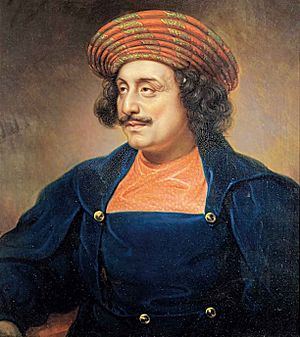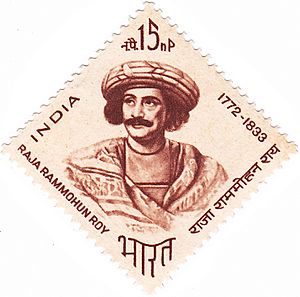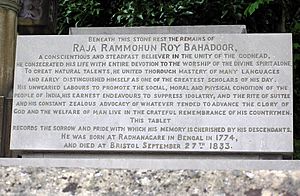Ram Mohan Roy facts for kids
Quick facts for kids
Raja Ram Mohan Roy
|
|
|---|---|

Roy in London (1833), portrait by Rembrandt Peale
|
|
| Born | c. 22 May 1772 Radhanagar, Bengal Presidency, British India
|
| Died | 27 September 1833 (aged 61) Stapleton, Bristol, England
|
| Nationality | Indian |
| Other names | Herald of New Age |
| Occupation | Social and religious reformer; Brahmin prince, author |
| Known for | Bengal Renaissance, Brahmo Sabha (social, political reforms) |
Raja Ram Mohan Roy (born May 22, 1772 – died September 27, 1833) was a very important Indian reformer. He helped start the Brahmo Samaj, a group that worked for social and religious changes in India. The Mughal Emperor, Akbar II, gave him the special title of "Raja," which means king.
Raja Ram Mohan Roy made a big difference in many areas. These included politics, how public services were run, education, and religion. He is most famous for trying to stop harmful practices like sati (where a widow would burn herself on her husband's funeral pyre) and child marriage. Many historians call him the "Father of the Bengal Renaissance." This means he helped bring new ideas and a fresh way of thinking to Bengal.
In 2004, a BBC poll named him the 10th greatest Bengali person of all time.
Contents
His Early Life and Learning
Ram Mohan Roy was born in a place called Radhanagar in the Hooghly District of Bengal Presidency. His family was from a high social group called Kulin Brahmins. In those days, some Kulin Brahmins would marry many women to get dowries, which was a practice Ram Mohan Roy later fought against.
His father, Ramkanta, followed Vaishnavism, a branch of Hinduism. His mother, Tarini Devi, came from a family that followed Shaivism. Ram Mohan Roy was a very smart student. He learned many languages, including Sanskrit, Persian, English, Arabic, Latin, and Greek.
He was married three times. His first wife passed away early. He had two sons, Radhaprasad and Ramaprasad, with his second wife. She died in 1824. His third wife lived longer than him.
People disagree about the exact details of his early schooling. Some say he started in a village school. There he learned Bengali, some Sanskrit, and Persian. Later, he might have studied Persian and Arabic in Patna. After that, he went to Varanasi to learn more about Sanskrit and Hindu scriptures. These included the Vedas and Upanishads.
His studies in Persian and Arabic helped him think about the idea of "One God." This idea became very important in his later work.
Working with the East India Company
Ram Mohan Roy worked for the East India Company for some years. This was a British company that ruled parts of India. He also worked as a moneylender. He lent money to British officers who spent more than they earned.
In 1795, he met a Christian missionary named William Carey. Ram Mohan Roy wanted to learn English from him. They worked together for a while, even on some religious texts.
In 1804, Ram Mohan Roy wrote a book called Tuhfat-ul-Muwahhidin. The title means "A Gift to Monotheists." He wrote it in Persian, with an introduction in Arabic. In this book, he shared his early ideas about believing in one God.
By 1815, he started a group called Atmiya Sabha in Kolkata. This was a place where people could meet and discuss philosophical ideas.
Ram Mohan Roy noticed that the East India Company was taking a lot of money out of India. He believed that allowing more Europeans to settle and trade freely in India might help with this economic problem.
Fighting for Change: Social and Religious Reforms
For many years, Ram Mohan Roy worked hard to change things he saw as wrong in Indian society. He especially focused on the Kulin Brahmin priestly group, which was his own family's background.
Ending Harmful Practices
Ram Mohan Roy strongly fought against several harmful Hindu customs. These included:
- Sati: The terrible practice where a widow would burn herself on her husband's funeral pyre. He worked tirelessly to get this practice banned.
- Polygamy: The practice of one man having many wives.
- Child marriage: Marrying children at a very young age.
- Caste system: The strict social division of people into groups.
He also believed that women should have the right to inherit property. In 1828, he created the Brahmo Sabha. This group of reform-minded Brahmins worked to fight against these social problems.
Ram Mohan Roy felt that some Hindu traditions were not respected by Westerners. He wanted to show that the "superstitious practices" were not part of the true spirit of Hinduism. He believed that by removing these practices, Hinduism would be seen as a fair and just religion, similar to Christian ideals.
Believing in One God
Ram Mohan Roy's religious ideas were very important. He studied the Quran, the Vedas, and the Upanishads. His beliefs combined parts of Hinduism, Islam, and other ideas like Deism (belief in a God who created the universe but does not interfere) and Unitarianism (belief in one God, not a Trinity).
The Brahmo Samaj group, which he helped found, believes in one Supreme God. They believe this God has a distinct personality and moral qualities. They also believe that you can worship God anywhere and at any time, as long as your mind is focused on Him.
Champion of Education
Ram Mohan Roy believed that education was key to making society better. He wanted to bring modern, Western learning to India.
- In 1817, he worked with David Hare to set up the Hindu College in Calcutta.
- He founded the Anglo-Hindu school in 1822. Four years later, in 1826, he started the Vedanta College. At this college, he made sure that his teachings about one God were taught alongside modern Western subjects.
- In 1830, he helped Rev. Alexander Duff start the General Assembly's Institution (now Scottish Church College).
- He also started the Vedanta College, which combined Western and Indian learning.
- His most popular newspaper was the Sambad Kaumudi. It talked about important topics like freedom of the press and allowing Indians to hold higher positions in government.
- When the British government tried to control the press, Ram Mohan Roy wrote strong letters against it in 1829 and 1830.
His Journey to England and Final Days
In 1830, Raja Ram Mohan Roy traveled to the United Kingdom. He went as a representative of the Mughal Emperor, Akbar Shah II. His main goal was to make sure that the British government would not overturn the law banning Sati, which Lord William Bentinck had passed in 1829. He also asked the King to increase the Mughal Emperor's allowance. He was successful in getting the Emperor's payment increased by £30,000.
While in England, he met with members of Parliament and published books about India's economy and laws. He also visited France.
Raja Ram Mohan Roy passed away in Stapleton, near Bristol, England, on September 27, 1833. He died from meningitis, a serious illness. He was buried in the Arnos Vale Cemetery in Bristol.
His Lasting Impact
Raja Ram Mohan Roy's support for English education and Western ideas led to some debates. For example, Mahatma Gandhi did not agree with Roy's strong focus on English education. Gandhi called him a "pygmy" (meaning small or unimportant) in this regard. However, Rabindranath Tagore, whose grandfather helped pay for Roy's tomb, disagreed. Tagore said that Roy had a deep understanding of Indian wisdom and was not just a student of the West.
Gandhi later explained his own view on cultures: "I do not want my house to be walled in on all sides and my windows to be stuffed. I want the culture of all lands to be blown about my house as freely as possible. But I refuse to be blown off my feet by any."
Today, Raja Ram Mohan Roy is still remembered. In 1983, a big exhibition about him was held in Bristol. His large portrait from 1831 still hangs there. In Bristol's city center, there is a bronze statue of him. A path in Stapleton has even been named "Rajah Rammohun Walk." His tomb at Arnos Vale is a protected historic site and many people visit it.
See also
 In Spanish: Ram Mohan Roy para niños
In Spanish: Ram Mohan Roy para niños




